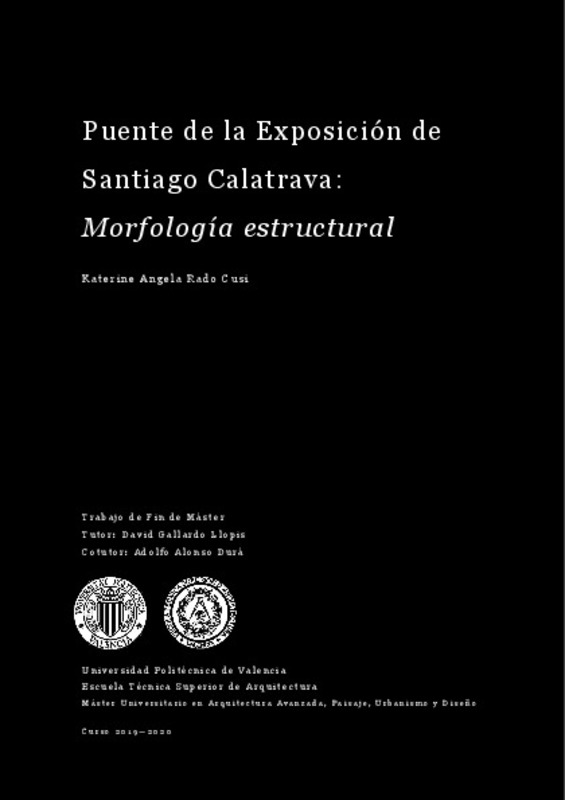|
Resumen:
|
[ES] La obra de Calatrava en Valencia, para bien o para mal, ha marcado un hito en la arquitectura de la ciudad: por la introducción de un nuevo lenguaje de formas, por los recursos excesivos que se necesitaron para ...[+]
[ES] La obra de Calatrava en Valencia, para bien o para mal, ha marcado un hito en la arquitectura de la ciudad: por la introducción de un nuevo lenguaje de formas, por los recursos excesivos que se necesitaron para ejecutarla y después mantenerla, por los problemas , o por la notoriedad que ha traído consigo. De ahí, la gran cantidad de bibliografía dedicada a esta obra.
Sin embargo, sorprende que, dada la envergadura de las intervenciones de Calatrava en Valencia, esta literatura sea solo un compendio de descripciones, opiniones e imágenes, mas no existe un análisis objetivo.
Sean detractores o defensores del trabajo de Calatrava, la mayoría coincide en que el arquitecto/ingeniero/artista ha llegado a ver como falsa toda opinión convencional, decidiendo desarrollar el tesauro Calatrava . Él mismo afirma: Mi interés se centra en introducir un nuevo vocabulario, de las formas blandas, de carácter surrealista.
Muchos autores sugieren que este tesauro responde a un proceso de descubrimiento, más que de invención. Descubrimiento del lenguaje formal de las fuerzas estructurales. El arquitecto Meilli afirma que a Calatrava le obsesiona la experiencia estética de la naturaleza y la estática de una superficie que se arriostre a sí misma.
Sin embargo, ¿es esto cierto?, ¿realmente las fuerzas guían la elección formal de Calatrava? -en muchos casos extravagante, consumiendo recursos excesivos-. De ser así, ¿en qué medida el arquitecto optimiza el comportamiento estructural?
Considerando esta realidad, el presente trabajo de fin de máster desarrollará el estudio de la morfología estructural del Puente de la Exposición de Calatrava, para determinar si la forma del puente es o no, a un tiempo, escultórica y funcional.
Se recolectará toda la información disponible en la bibliografía dedicada al puente, se desarrollará el modelo tridimensional en AutoCAD, dicho modelo será sometido a las fuerzas correspondientes al caso, en el programa de cálculo: SAP2000. Y, haciendo uso del método experimental, se elaborarán modelos tridimensionales con variaciones morfológicas, creando así, las condiciones necesarias que permitan responder a las preguntas planteadas.
La introducción del nuevo lenguaje de formas de Calatrava ha planteado gran cantidad de dificultades en las distintas etapas de las obras. Dificultades de carácter técnico, económico y funcional.
Para mayor comprensión del término, véase, TZONIS A. (2004). Santiago Calatrava. Obra completa. Barcelona: Polígrafa. Pp. 53.
Véase, LLÁTZER MOIX. (2016). Queríamos un Calatrava. Viajes arquitectónicos por la seducción y el repudio. Barcelona: Anagrama. Pp. 34.
Profesor del departamento de arquitectura de la Escuela Politécnica Federal de Zúrich (ETH Zürich).
Véase, BLASER W. (1989). Santiago Calatrava. Ingeniero Arquitecto. Barcelona: Gustavo Gili. Pp.19.
[-]
[EN] The work of Calatrava in Valencia, for better or for worse, has marked a milestone in the architecture of the city: by the introduction of a new language of forms, by the excessive resources that were needed to execute ...[+]
[EN] The work of Calatrava in Valencia, for better or for worse, has marked a milestone in the architecture of the city: by the introduction of a new language of forms, by the excessive resources that were needed to execute it and then maintain it, by the problems , or because of the notoriety it has brought with it. Hence, the large amount of bibliography devoted to this work.
However, it is surprising that, given the scale of the interventions of Calatrava in Valencia, this literature is only a compendium of descriptions, opinions and images, but there is no objective analysis.
Detractors or defenders of the work of Calatrava, most agree that the architect / engineer/artist has come to see as false all conventional opinion, deciding to develop the "Calatrava thesaurus" . He himself states: "My interest is focused on introducing a new vocabulary, of soft forms, of a surrealist nature."
Many authors suggest that this thesaurus responds to a discovery process, rather than an invention. Discovery of the formal language of structural forces. The architect Meilli affirms that Calatrava is obsessed by "the aesthetic experience of nature and the static of a surface that braces itself."
However, is this true? do the forces really guide the formal election of Calatrava? - in many cases extravagant, consuming excessive resources. If so, to what extent does the architect optimize the structural behavior?
Considering this reality, the present thesis of master will develop the study of the structural morphology of the Calatrava Exposition Bridge, to determine if the bridge s form is or is not, at the same time, sculptural and functional.
All the information available in the bibliography dedicated to the bridge will be collected, the three-dimensional model will be developed in AutoCAD, said model will be subjected to the forces corresponding to the case, in the calculation program: SAP2000. And, using the experimental method, tests will be performed altering the morphology of the bridge, thus creating the necessary conditions to answer the questions posed.
The introduction of the new form language of Calatrava has posed a lot of difficulties in the different stages of the works. Difficulties of a technical, economic and functional nature.
For a better understanding of the term, see, TZONIS A. (2004). Santiago Calatrava. Obra completa. Barcelona: Polígrafa. P. 53.
See, LLÁTZER MOIX. (2016). Queríamos un Calatrava. Viajes arquitectónicos por la seducción y el repudio. Barcelona: Anagrama. P. 34.
Professor of the Department of Architecture of the Federal Polytechnic School of Zurich (ETH Zürich).
See, BLASER W. (1989). Santiago Calatrava. Ingeniero Arquitecto. Barcelona: Gustavo Gili. P. 19.
[-]
|







